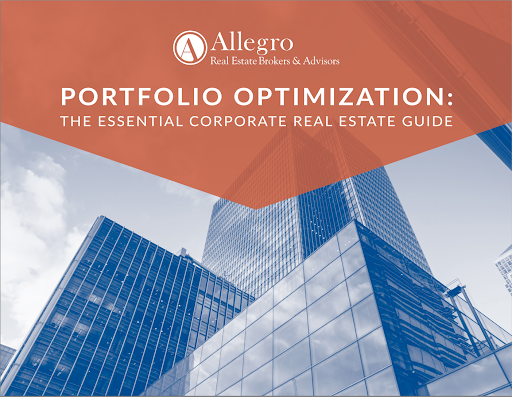University Landlord Retains Valuable Tenant Despite Building & Lease Complexities and Fierce Competition

2020 NAIOP Office Transaction of the Year
Located in a historic theatre district, the property is an early 20th century office building with a complex configuration, ownership, and lease structure. These obstacles made it clear to the owner that an experienced commercial real estate advisor was vital during lease renewal negotiations with a major tenant of the property.
Allegro Real Estate Brokers & Advisors rose to the challenge—an untraditional move for the firm to represent the landlord rather than tenants—overcoming fierce competition from established downtown spaces and landlords.
A Mixed-Use Building with a Historic Past
The building started its life as a two-story parking garage. It was later expanded to five floors. The 60,000-square-foot floor plates once served as home to government offices as well as a fitness club. Today, the building consists of 240,000 square feet of office and classroom space with first-floor parking.
The former owner-occupant, an engineering and architectural firm, sold the property to a special purpose entity in 2010 with the intent for the university to locate its arts, theater, and dance academic programming in the building. Around that time, the surrounding area was undergoing a period of considerable improvement—for instance, the theater district buildings underwent improvements totaling more than $30 million. Shortly after the purchase, the subject property was substantially renovated, due in part to a $15 million allocation of New Market Tax Credits secured by the special purpose entity.
A Master Lease Agreement that Creates Complexity
Concurrent with the building purchase in 2010, the special purpose entity executed a master lease with a university for the entire building. As part of the consideration for that lease, the university agreed to pay the balance of the “balloon payment” that was due at the end of the New Market Tax Credits compliance period.
The university also agreed to sublease 120,000 square feet to the seller (the engineering firm), and 29,000 square feet to a non-profit theater group, both for 10-year terms. In exchange for this consideration, the special purpose entity included within the master lease a bargain purchase option, which allowed the university to purchase the special purpose entity (and thus ownership of the building) for a nominal value at the university’s discretion. This complicated lease structure resulted in a number of practical implications (and complications):
- The special purpose entity owned the building.
- The university could purchase the ownership entity for a nominal value at its discretion.
- The university held a master lease for the entire building.
- The university was responsible for the balloon payment stemming from the New Market Tax Credits funds used to improve the building.
- The engineering firm and the non-profit theater group became subtenants in the building for each of their 10-year terms.
Lease Renewal Negotiations with a Twist
The time came when the engineering firm’s sublease approached expiration, and the company wanted to negotiate the amount of square feet it leased to reduce its footprint by 50%, from 120,000 square feet to just 60,000. The university faced a number of challenges with these lease negotiations.
- Inexperience: The university, as a public educational institution, was disadvantaged by its organizational structure and lack of experience as a professional office landlord. Competing landlords could quickly analyze and respond to Requests for Proposal (“RFP”s) and engage in discussions about lease terms. The university needed to address this challenge to remain competitive in the process, and to provide responses complying with the tenant’s deadlines.
- Public Entity Regulations: Public institutions like the university have a number of restrictions placed on them concerning owning and leasing commercial real estate. For example, the university was required to bid out certain scopes of work and comply with regulations, such as prevailing wage, which complicates negotiations.
- Building Configuration: The building’s architects, when they designed the building as a parking garage, did not anticipate the building being used as a multi-tenant structure. As a result the building had a number of shortcomings. For example, the building could not separately meter some utilities. Methods of allocation needed to be created and agreed upon by both parties which might normally deter some tenants.
- Parking & Signage: The university could not afford to be overly generous with its allocation of parking spaces and signage rights because the engineering firm would now represent only 25% of the building’s occupancy. The university needed to preserve these resources/opportunities to attract future tenants to the remaining vacant 60,000 square feet of space to be vacated.
- Campus Vibe: The university used space on the second and fifth floors for its arts, theater, and dance programming. Some commercial tenants prefer not to lease space in a building that has a “campus vibe.” The university had to overcome this reality, particularly given the lead time required to lease up to 120,000 square feet, while paying carrying costs on the vacant space. The engineering firm was aware of this challenge.
The Negotiations Begin
The university engaged Allegro to provide consulting services and landlord representation during the lease negotiations.
The university asked Allegro to analyze the consequences of various occupancy, financing, and capital expenditure decisions related to the building and the impending balloon payment. Allegro conducted this analysis and delivered its findings and recommendations.
The university then hired Allegro to represent it during its renewal negotiations with the engineering firm. The engineering firm hired a tenant representation team from a competing firm to represent the company in the negotiations. The engineering firm was interested in “going out to market” and entertaining proposals from other landlords throughout the central business district. The engineering firm indicated that it preferred moving into a more contemporary multi-tenant office building that offered amenities.
The Allegro team leveraged its deep market knowledge to provide thorough and detailed analysis and advice. Shortly after accepting the engagement, Allegro analyzed the central business district market to identify competing opportunities that were available to the engineering firm. Allegro subjected each location to a qualitative and quantitative analysis to determine the strengths and weaknesses of each building, comparing those attributes with the subject property.
Allegro also leveraged the knowledge gained through its prior consulting engagements with the university to determine critical issues, engagement limitations, and key performance metrics for the transaction. Allegro worked with the university to address and mitigate limitations, create a process for responding to RFP questions quickly, and analyze the financial impact of deal terms and conditions.
Unique Solutions for a Unique Building
Allegro formed a small working committee within the university. This committee operated under the supervision of a larger decision-making board. This process allowed the university to compete with professional landlords without significant delay.
Allegro provided direction on RFP responses, and created dozens of “what-if” financial modeling scenarios. Allegro remained acutely aware of the building’s history and its complex legal structure, and the potential impacts those factors could have on landlord concessions or the ultimate structure of the transaction.
This unique building, with its complex ownership and leasing structure, required some unique solutions. Allegro delivered:
Improvement Consideration
The engineering firm was seeking extensive parking/signage rights, and had significant leverage in lease discussions because of its size and the prospect of the university needing to lease 120,000 square feet of vacant space. Allegro helped the university navigate these conversations without providing concessions that would jeopardize the attraction of future tenants. To provide this insight, Allegro leveraged its experience representing other tenants in the central business district market, and helped the university understand the limits they should put in place to both persuade the engineering firm to stay, but also to protect future leasing opportunities.
Leveraging Resources/Amenities
Allegro helped the university to explore the costs and benefits associated with providing additional amenities. For example, Allegro coordinated space planning exercises with the university’s architectural firm to explore upgrading common areas, installing a fitness center, and installing a restaurant that would bring additional foot traffic from the historic theater district. Allegro also led conversations inquiring about discounts to the university’s recreation center, and the possibility of allowing tenants to host events or rent conference facilities on campus. Although these amenities were not included in the final transaction, they represented creative ways the university could add value.
Parking Solution
Allegro took the initiative to conduct a parking study of nearby lots and garages to understand rates and opportunities for negotiating bulk pricing. This research eventually led to a conversation between the engineering firm and a local parking lot operator, resulting in an acceptable agreement that pushed the deal over the finish line.
Coordinating Swing Space
The final lease agreement contained concessions for tenant improvements. In addition to determining the appropriate dollar value for the concessions, Allegro helped the university to create an improvement timeline. The timeline required the engineering firm to vacate half of its space, so further agreement was required regarding the use of swing space in the building and the appropriate changes associated with the swing space. Allegro supported the university in the negotiations for this swing space and memorialized this within the lease document.
Coordinating Improvements
As part of the lease, the university agreed to make a number of common area/building improvements. At the insistence of the engineering firm, the university included a timeline in the lease that specified when these improvements would be completed. Allegro and the university worked together to approve the list of projects and draft the compliance timeline. Because of the regulations that governed the university, planning these improvements was particularly challenging. Allegro’s advice helped the university navigate this issue and plan common area improvements that made the remaining vacant space more marketable.
A Satisfactory Conclusion
Despite Allegro facing several challenges (serving an untraditional landlord, offering less traditional office space on larger floor plates, and negotiating with a tenant eager to move to a new location), Allegro ultimately represented the university in a transaction that retained the engineering firm as a 60,000-square-foot tenant in the subject property for an 11-year term.
Allegro helped the university accomplish more than simply retain a valuable tenant:
- Preserving Income Stream: The university ensured the continuation of a valuable income stream over an 11-year term, and prevented 60,000 square feet from becoming vacant.
- Preserving Options: The final transaction struck a balance between ensuring the engineering firm stayed in the building, while protecting valuable assets (such as parking and signage) that will attract other tenants to the building.
- Preserving Relationships: This transaction preserved the relationship between the engineering firm and the university. These two entities have both been occupants together in the building for over a decade. During that time, there has been a growing affinity between the two organizations and increased cooperation.
- A Template for Future Transactions: This transaction gave the university a crash course in commercial real estate, and taught the organization valuable lessons about what it takes to be a professional landlord. The experience that the university gained through these negotiations will serve as a deal template for years to come.
Does your real estate team go above and beyond? At Allegro Realty, we problem-solve differently. Contact us to talk about your real estate needs today.
More Case Studies



Subscribe
Get the latest real estate advice and insights from Allegro experts sent straight to your inbox.




